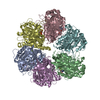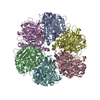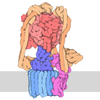+ Open data
Open data
- Basic information
Basic information
| Entry | Database: PDB / ID: 8spv | ||||||
|---|---|---|---|---|---|---|---|
| Title | PS3 F1 Rotorless, no ATP | ||||||
 Components Components |
| ||||||
 Keywords Keywords | TRANSLOCASE / membrane / ATP synthase / electron transport | ||||||
| Function / homology |  Function and homology information Function and homology informationH+-transporting two-sector ATPase / proton-transporting ATP synthase complex / proton-transporting ATP synthase activity, rotational mechanism / ADP binding / ATP binding / plasma membrane Similarity search - Function | ||||||
| Biological species |  | ||||||
| Method | ELECTRON MICROSCOPY / single particle reconstruction / cryo EM / Resolution: 3.06 Å | ||||||
 Authors Authors | Sobti, M. / Stewart, A.G. | ||||||
| Funding support |  Australia, 1items Australia, 1items
| ||||||
 Citation Citation |  Journal: Structure / Year: 2024 Journal: Structure / Year: 2024Title: The series of conformational states adopted by rotorless F-ATPase during its hydrolysis cycle. Authors: Meghna Sobti / Hiroshi Ueno / Simon H J Brown / Hiroyuki Noji / Alastair G Stewart /   Abstract: FF ATP synthase interchanges phosphate transfer energy and proton motive force via a rotary catalytic mechanism and isolated F-ATPase subcomplexes can also hydrolyze ATP to generate rotation of their ...FF ATP synthase interchanges phosphate transfer energy and proton motive force via a rotary catalytic mechanism and isolated F-ATPase subcomplexes can also hydrolyze ATP to generate rotation of their central γ rotor subunit. As ATP is hydrolyzed, the F-ATPase cycles through a series of conformational states that mediates unidirectional rotation of the rotor. However, even in the absence of a rotor, the α and β subunits are still able to pass through a series of conformations, akin to those that generate rotation. Here, we use cryoelectron microscopy to establish the structures of these rotorless states. These structures indicate that cooperativity in this system is likely mediated by contacts between the β subunit lever domains, irrespective of the presence of the γ rotor subunit. These findings provide insight into how long-range information may be transferred in large biological systems. | ||||||
| History |
|
- Structure visualization
Structure visualization
| Structure viewer | Molecule:  Molmil Molmil Jmol/JSmol Jmol/JSmol |
|---|
- Downloads & links
Downloads & links
- Download
Download
| PDBx/mmCIF format |  8spv.cif.gz 8spv.cif.gz | 526.7 KB | Display |  PDBx/mmCIF format PDBx/mmCIF format |
|---|---|---|---|---|
| PDB format |  pdb8spv.ent.gz pdb8spv.ent.gz | 433.6 KB | Display |  PDB format PDB format |
| PDBx/mmJSON format |  8spv.json.gz 8spv.json.gz | Tree view |  PDBx/mmJSON format PDBx/mmJSON format | |
| Others |  Other downloads Other downloads |
-Validation report
| Summary document |  8spv_validation.pdf.gz 8spv_validation.pdf.gz | 1.3 MB | Display |  wwPDB validaton report wwPDB validaton report |
|---|---|---|---|---|
| Full document |  8spv_full_validation.pdf.gz 8spv_full_validation.pdf.gz | 1.3 MB | Display | |
| Data in XML |  8spv_validation.xml.gz 8spv_validation.xml.gz | 75.4 KB | Display | |
| Data in CIF |  8spv_validation.cif.gz 8spv_validation.cif.gz | 113.7 KB | Display | |
| Arichive directory |  https://data.pdbj.org/pub/pdb/validation_reports/sp/8spv https://data.pdbj.org/pub/pdb/validation_reports/sp/8spv ftp://data.pdbj.org/pub/pdb/validation_reports/sp/8spv ftp://data.pdbj.org/pub/pdb/validation_reports/sp/8spv | HTTPS FTP |
-Related structure data
| Related structure data |  40687MC  8spwC  8spxC M: map data used to model this data C: citing same article ( |
|---|---|
| Similar structure data | Similarity search - Function & homology  F&H Search F&H Search |
- Links
Links
- Assembly
Assembly
| Deposited unit | 
|
|---|---|
| 1 |
|
- Components
Components
| #1: Protein | Mass: 51788.184 Da / Num. of mol.: 3 Source method: isolated from a genetically manipulated source Source: (gene. exp.)   References: UniProt: A0A0M3VGF9, H+-transporting two-sector ATPase #2: Protein | Mass: 51584.598 Da / Num. of mol.: 3 Source method: isolated from a genetically manipulated source Source: (gene. exp.)   References: UniProt: A0A0M4U1P9, H+-transporting two-sector ATPase |
|---|
-Experimental details
-Experiment
| Experiment | Method: ELECTRON MICROSCOPY |
|---|---|
| EM experiment | Aggregation state: PARTICLE / 3D reconstruction method: single particle reconstruction |
- Sample preparation
Sample preparation
| Component | Name: PS3 F1 Rotorless / Type: COMPLEX / Entity ID: all / Source: RECOMBINANT |
|---|---|
| Source (natural) | Organism:  |
| Source (recombinant) | Organism:  |
| Buffer solution | pH: 7 |
| Specimen | Embedding applied: NO / Shadowing applied: NO / Staining applied: NO / Vitrification applied: YES |
| Vitrification | Cryogen name: ETHANE |
- Electron microscopy imaging
Electron microscopy imaging
| Experimental equipment |  Model: Titan Krios / Image courtesy: FEI Company |
|---|---|
| Microscopy | Model: FEI TITAN KRIOS |
| Electron gun | Electron source:  FIELD EMISSION GUN / Accelerating voltage: 300 kV / Illumination mode: FLOOD BEAM FIELD EMISSION GUN / Accelerating voltage: 300 kV / Illumination mode: FLOOD BEAM |
| Electron lens | Mode: BRIGHT FIELD / Nominal defocus max: 1000 nm / Nominal defocus min: 1000 nm |
| Image recording | Electron dose: 50 e/Å2 / Film or detector model: GATAN K2 QUANTUM (4k x 4k) |
- Processing
Processing
| CTF correction | Type: PHASE FLIPPING ONLY | ||||||||||||||||||||||||
|---|---|---|---|---|---|---|---|---|---|---|---|---|---|---|---|---|---|---|---|---|---|---|---|---|---|
| 3D reconstruction | Resolution: 3.06 Å / Resolution method: FSC 0.143 CUT-OFF / Num. of particles: 363810 / Symmetry type: POINT | ||||||||||||||||||||||||
| Refine LS restraints |
|
 Movie
Movie Controller
Controller





 PDBj
PDBj


